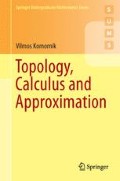Abstract
Metric spaces are very convenient in the study of continuity and uniform continuity. In this chapter we generalize a number of results on real sequences and functions of a real variable to sequences and functions defined on arbitrary metric spaces.
Access this chapter
Tax calculation will be finalised at checkout
Purchases are for personal use only
Notes
- 1.
We have \(\mathop{\mathrm{diam}}\nolimits \varnothing = -\infty\), and \(\mathop{\mathrm{diam}}\nolimits A \in [0,\infty ]\) otherwise.
- 2.
Such sequences are called eventually constant.
- 3.
See, e.g., Lemma 1.5 below.
- 4.
See, e.g., the proof of Theorems 6.2, 7.7, and Exercise 11.4 below, pp. 148, 179 and 281. See also Proposition 1.2.4, p. 292.
- 5.
If xy ≤ 2, then we have − 1 ≤ xy − 2 ≤ 0, and therefore | xy − 2 | ≤ 1 ≤ xy.
- 6.
See Exercise 1.1 for a generalization, p. 280.
- 7.
Of course, \(\mathop{\mathrm{diam}}\nolimits F_{n}\) is the length of this interval.
- 8.
See also Exercise 1.14 (iii) (p. 34) for one of its first applications.
- 9.
Indeed, if \(z \in X\setminus \overline{B}_{r}(x)\), then s: = d(z, x) − r > 0 and \(B_{s}(z) \subset X\setminus \overline{B}_{r}(x)\).
- 10.
See Exercise 1.15 (p. 34) and the comments on p. 339 on the continuous extension of continuous functions.
- 11.
This is called the closure of h(X), see the end of Sect. 2.1 below, p. 42.
- 12.
Representing x n by the vertical halfline \(\left \{(n,t) \in \mathbb{R}^{2}\:\ t \leq x_{n}\right \}\), x n is a peak if (n, x n ) is “visible from the right”.
- 13.
The empty set is compact because there is no sequence to check this property.
- 14.
By Proposition 1.21 (b) the hypotheses are satisfied if (F n ) is a non-increasing sequence of non-empty closed sets in a compact metric space X.
- 15.
If one of the sets has only one point, e.g., if \(K = \left \{a\right \}\), then we write \(\mathop{\mathrm{dist}}\nolimits (a,L)\) instead of \(\mathop{\mathrm{dist}}\nolimits (\left \{a\right \},L)\).
- 16.
See the footnote to Corollary 1.29 below on the terminology “precompact”.
- 17.
Since the closure of a totally bounded set is still totally bounded (see the footnote on p. 22 on the notion of closure), hence a set in a complete metric space is precompact if and only if its closure is compact.
- 18.
The completion of \(\mathbb{Q}\) for this metric is the field of p-adic numbers.
- 19.
A function satisfying the last condition is called subadditive.
- 20.
An interval is non-degenerate if it has at least two (and hence infinitely many) points.
- 21.
The superscript ∗ indicates that the intervals (a i , b i ) are pairwise disjoint. The union may be finite or even empty.
- 22.
The upper semi-continuity means that if ω f (x) < A, then ω f (y) < A for all y in a neighborhood of x. See also Exercise 2.11, p. 64.
Author information
Authors and Affiliations
Rights and permissions
Copyright information
© 2017 Springer-Verlag London Ltd.
About this chapter
Cite this chapter
Komornik, V. (2017). Metric Spaces. In: Topology, Calculus and Approximation. Springer Undergraduate Mathematics Series. Springer, London. https://doi.org/10.1007/978-1-4471-7316-8_1
Download citation
DOI: https://doi.org/10.1007/978-1-4471-7316-8_1
Published:
Publisher Name: Springer, London
Print ISBN: 978-1-4471-7315-1
Online ISBN: 978-1-4471-7316-8
eBook Packages: Mathematics and StatisticsMathematics and Statistics (R0)

